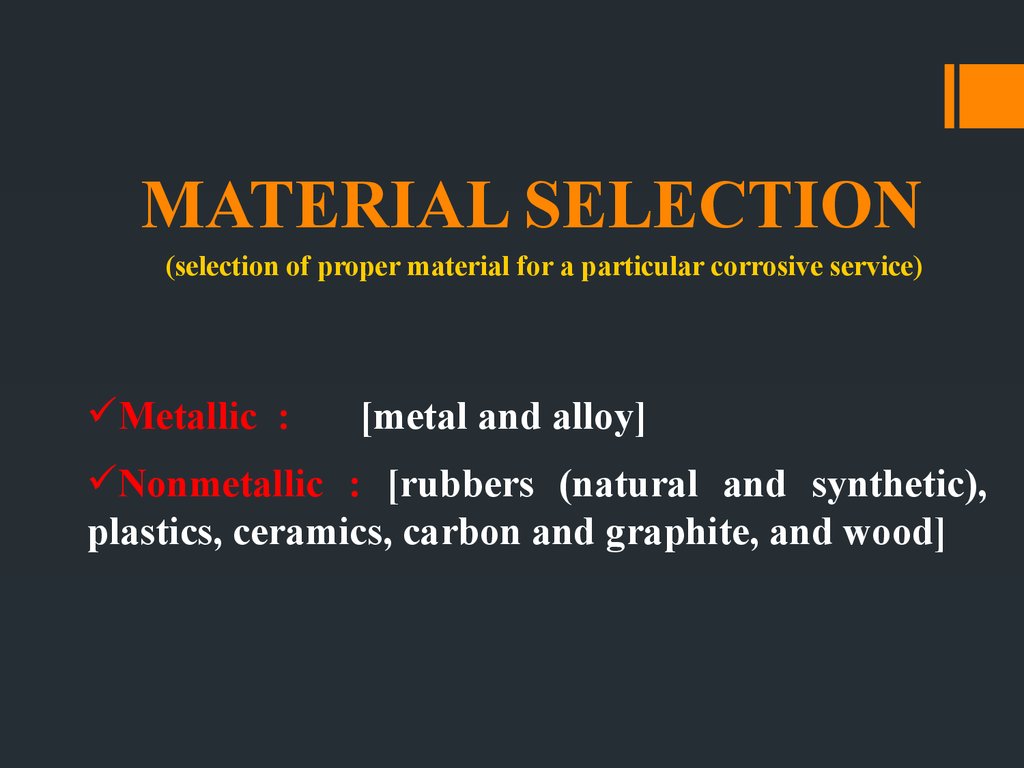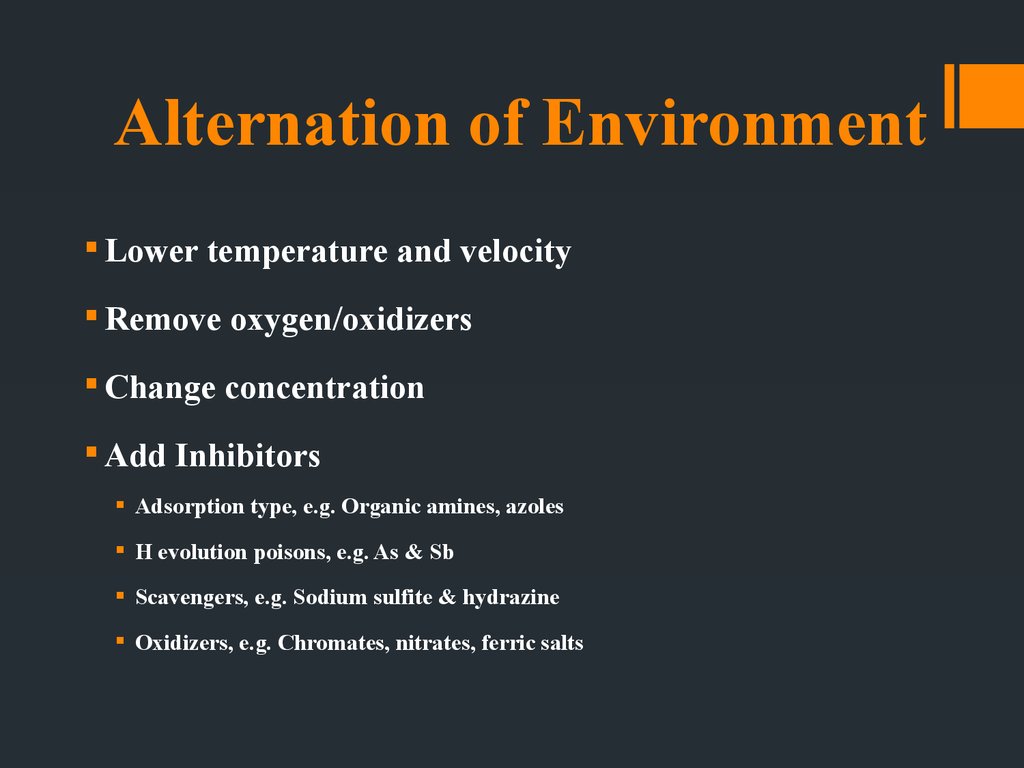Похожие презентации:
Prevention of corrosion
1. PREVENTION OF CORROSION
The huge annual loss due to corrosion is a national waste andshould be minimized
Materials already exist which, if properly used, can eliminate
80 % of corrosion loss
Proper understanding of the basics of corrosion and
incorporation in the initial design of metallic structures is
essential
2.
Factors that affect the rate ofcorrosion
Temperature
Oxygen
Humidity
Chemical Salts
Chemicals and airborne gases
3. How to avoid (or control) Corrosion?
?How to avoid (or control) CorrosionMaterial Selection! Remember – environment key.
Look at potential pH diagrams!!!
Eliminate any one of the 4 req’ments for corrosion!
Galvanic - Avoid using dissimilar metals.
Or close together as possible
Or electrically isolate one from the other
Or MAKE ANODE BIG!!!
4. How to avoid (or control) Corrosion?
?How to avoid (or control) CorrosionPitting/Crevice: Watch for stagnate water/ electrolyte.
Use gaskets
Use good welding practices
Intergranular – watch grain size, environment,
temperature, etc.. Careful with Stainless Steels and AL.
5. How to avoid (or control) Corrosion?
?How to avoid (or control) CorrosionConsider organic coating (paint, ceramic, chrome,
etc.) – DANGER IF IT GETS SCRACTHED!!
OR BETTER YET, consider cathodic protection:
such as zinc (or galvanized) plating on steel
Mg sacrificial anode on steel boat hull
Impressed current, etc..
6. Methodes To Control Corrosion
Design of structuresMaterial selection
Cathodic Protection
Reduce the activity of the cathode and or electrolyte. (Polarization)
Protection of the Anode. (Passivation)
Alteration of environment
Inhibitors
• Protective Coatings
7. DESIGN OF STRUCTURES
Avoid sharp cornersComplete draining of vessels
Avoid sudden changes in section
Avoid contact between dissimilar metals
Weld rather than rivet
Easy replacement of vulnerable parts
Avoid excessive mechanical stress
8. Design Do’s & Don’ts
Design Do’s & Don’tsWall thickness – allowance to accommodate for corrosion effect.
Avoid excessive mechanical stresses and stress concentrations in
components exposed to corrosive mediums. Esp when using materials
susceptible to SCC.
Avoid galvanic contact / electrical contact between dissimilar metals to
prevent galvanic corrosion.
Avoid sharp bends in piping systems when high velocities and/or solid in
suspension are involved – erosion corrosion.
Avoid crevices – e.g weld rather than rivet tanks and other containers,
proper trimming of gasket, etc.
9.
Avoid sharp corners – paint tends to be thinner at sharp cornersand often starts to fail.
Provide for easy drainage (esp tanks) – avoid remaining liquids
collect at bottom. E.g steel is resistant against concentrated sulfuric
acid but if remaining liquid is exposed to air, acid tend to absorb
moisture, resulting in dilution and rapid attack occurs.
Avoid hot spots during heat transfer operations – localized heating
and high corrosion rates. Hot spots also tend to produce stresses –
SCC failures.
Design to exclude air – except for active-passive metals and alloys
coz they require O2 for protective films.
Most general rule : AVOID HETEROGENEITY!!!
10.
DESIGN for Corrosion11.
DESIGN for CorrosionBracket easier to
replace than
pipe!
12.
13.
14.
Material Selection15.
MATERIAL SELECTION(selection of proper material for a particular corrosive service)
Metallic :
[metal and alloy]
Nonmetallic : [rubbers (natural and synthetic),
plastics, ceramics, carbon and graphite, and wood]
16. IMPROVEMENTS OF MATERIALS
Purification of metals: Al , ZrMaking more noble, e.g. Pt in Ti
Passivating, e.g. Cr in steel
Inhibiting, e.g. As & Sb in brass
Scavenging, e.g. Ti & Nb in S.S
Improving other properties
17.
Material Selection - GalvanicSeries [Seawater at 77⁰ F.]
Magnesium
Zinc
Aluminum
Mild Steel
Cast Iron
Copper
Stainless Steel
Gold
Platinum
18.
Combining dissimilar metals can result incorrosion. It may be very rapid or it may be
relatively slow, depending on the metals combined,
the environment, and the ratio of one to the other.
We can also use this concept to protect a surface,
such as when we hot dip galvanize steel. The zinc
we apply to the steel is the more active metal and
will sacrifice itself to protect the steel. When we
combine zinc and steel the zinc becomes the anode
and the steel becomes the cathode.
19. Metals and Alloys
NoEnvironment
Proper material
1
Nitric acid
Stainless steels
2
Caustic
Nickel and nickel
alloys
3
Hydrofluoric acid
Monel (Ni-Cu)
4
Hot hydrochloric
acid
5
Dilute sulfuric acid
Hastelloys
(Ni-Cr-Mo)
Lead
20.
No6
7
8
9
10
Environment
Nonstaining atmospheric
exposure
Distilled water
Hot strong oxidizing
solution
Ultimate resistance
Concentrated sulfuric
acid
Proper material
Aluminium
Tin
Titanium
Tantalum
Steel
21. Cathodic Protection (CP)
Cathodic protection (CP) is a technique to control the corrosion of a metal surface bymaking it work as a cathode of an electrochemical cell. This is achieved by placing in
contact with the metal to be protected another more easily corroded metal to act as the
anode of the electrochemical cell. Cathodic protection systems are most commonly used to
protect steel, water or fuel pipelines and storage tanks, steel pier piles, ships, offshore
oil platforms and onshore oil well casings.
Types of CP:
sacrificial anodes (zinc, magnesium or aluminum): The sacrificial anodes are more
active (more negative potential) than the metal of the structure they’re designed to
protect. The anode pushes the potential of the steel structure more negative and
therefore the driving force for corrosion halts. The anode continues to corrode until
it requires replacement,
Impressed current CP: done for large structures (pipes, offshore platforms, etc)
where a galvanic (or sacrificial) anode can not economically deliver enough current.
Galvanized steel (see previous slide): again, steel is coated with zinc and if the zinc
coating is scratched and steel exposed, the surrounding areas of zinc coating form a
galvanic cell with the exposed steel and protects in from corroding. The zinc coating
acts as a sacrificial anode.
22. CATHODIC & ANODIC PROTECTION
CATHODIC & ANODICPROTECTION
Cathodic protection: Make the structure more cathodic by
Use of sacrificial anodes
Impressed currents
Galvanized steel
Anodic protection: Make passivating metal structures more
anodic by impressed potential. e.g. 316 s.s. pipe in sulfuric acid
plants.
23. Sacrificial Anodes
Galvanization of SteelDip steel sheet in molten zinc. Get a pretty thin coating.
Zinc will be anode. Steel exposed by crack is the cathode. Since we
have a huge anode having to be served by a small cathode, corrosion
rate will be slow.
Tiny cathode (steel)
Large area
anode (zinc)
An example of a favorable area ratio. Bad deal: huge cathode, tiny anode
24. Another Example
Zinc is attached to the steel hull of the vessel.Attachment points
25.
26. Sacrificial Anode for a Pipeline
27.
Aluminium anodes mounted on a steel jacketstructure – using galvanic corrosion for
corrosion control! Called cathodic protection
(aka sacrificial anode)
28. Impressed Voltage
By imposing a voltage which causes electrons to flow towards theobject to be protected, we make it less anodic and protect it from
corrosion damage.
29.
30.
See Exxon Mobil example31. Polarization
This is an effect which reduces the actual chemical potentialdriving of the cell. If the thermodynamic force driving the ion
into solution is reduced, this is polarization.
Easy example. By lowering the electrolyte temperature, we find
that it is usually less corrosive. Diffusion of ions is slowed.
Inhibitors are chemicals which slow corrosion. Some of them do
this by promoting the polarization of the cathode.
32. Passivation of the anode
We have two examples already. Stainless and aluminum.A thin oxide layer forms on the surface and isolates the metal
from the environment.
Zn, Mg, Cu and Ti are also capable of passivation under normal
conditions of operation.
Steel will also passivate in the presence of an alkaline
environment, such as rebar in concrete.
Corrosion inhibitors. Some of these, such as the chromates, are
capable of coating a steel and passivating it.
Coatings, paints, etc.
33. Effect of environmental parameters on the rate of corrosion
34.
NaCl 5.5%35.
NaCl, 5 atm 5.5%36.
NaCl, 85 °C 5.5%37.
NaCl, 10 °C, 15 atm 5.5%38. Alternation of Environment
Lower temperature and velocityRemove oxygen/oxidizers
Change concentration
Add Inhibitors
Adsorption type, e.g. Organic amines, azoles
H evolution poisons, e.g. As & Sb
Scavengers, e.g. Sodium sulfite & hydrazine
Oxidizers, e.g. Chromates, nitrates, ferric salts
39. Alteration of Environment
Typical changes in medium are :Lowering temperature –
but there are cases where
increasing T decreases attack. E.g hot, fresh or salt water is raised to
boiling T and result in decreasing O2 solubility with T.
Decreasing velocity –
exception ; metals & alloys that
passivate (e.g stainless steel) generally have better resistance to
flowing mediums than stagnant. Avoid very high velocity because of
erosion-corrosion effects.
40.
Removing oxygen or oxidizers – e.g vacuum treatment,inert gas sparging, or thru the use of oxygen scavengers.
However, not recommended for active-passive metals or
alloys. These materials require oxidizers to form protective
oxide films.
Changing concentration – higher concentration of acid
has higher amount of active species (H ions). However, for
materials that exhibit passivity, effect is normally negligible.
41. Environment factors affecting corrosion
Dust particles and man-made pollution – CO, NO, methane, etc.Temperature – high T & high humidity accelerates corrosion.
Rainfall – excess washes corrosive materials and debris but scarce may
leave water droplets.
Proximity to sea
Air pollution – NaCl, SO2, sulfurous acid, etc.
Humidity – cause condensation.
42.
InhibitorsInhibitors are materials that may be injected into the
system . They plate out on the surface and inhibit the
formation of corrosion cells. They are commonly
used in pipelines and other vessels that will contain
materials that are corrosive.
Some metals, such as gold and platinum, corrode very
slowly or not at all. Choosing a corrosion resistant
material can reduce the rate of corrosion.
43.
They are sometimes injected into the water streamthat may be used for the surface preparation of steel,
as in the case of water jetting.
In the formulation of some primers inhibitive
pigments are used . These inhibitive pigments
inhibit, or interfere, with the corrosion process.
Examples of inhibitive pigments are red lead and
barium meta borate.
44.
Why Metals Corrode –Recommended!!
http://www.westcoastcorrosion.com/Pa
pers/Why%20Metals%20Corrode.pdf
http://www.corrosionsource.com/
http://www.corrosioncost.com/home.html
http://www.intercorr.com/failures.html
http://www.3ninc.com/Cast_Magnesium
_Anodes.htm
http://en.wikipedia.org/wiki/1992_explos
ion_in_Guadalajara












































 Промышленность
Промышленность








